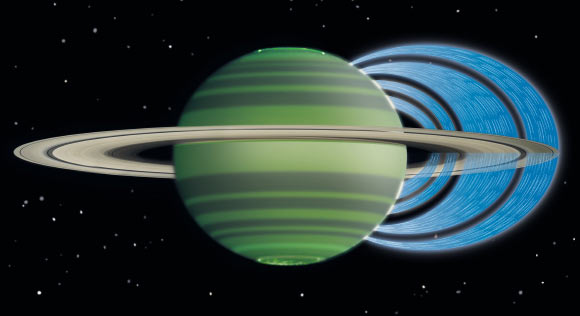New observations made with the W. M. Keck Observatory on Mauna Kea, Hawaii, have tracked the ‘rain’ of charged water particles into the atmosphere of Saturn.

This artist’s concept illustrates how charged water particles flow into the Saturnian atmosphere from the planet’s rings, causing a reduction in atmospheric brightness (NASA / JPL-Caltech / Space Science Institute / University of Leicester)
“Saturn is the first planet to show significant interaction between its atmosphere and ring system,” said Dr James O’Donoghue of the University of Leicester, lead author of a paper published in the journal Nature.
“The main effect of ring rain is that it acts to ‘quench’ the ionosphere of Saturn, severely reducing the electron densities in regions in which it falls.”
“The ring’s effect on electron densities is important because it explains why, for many decades, observations have shown electron densities to be unusually low at some latitudes at Saturn,” he said.
“It turns out a major driver of Saturn’s ionospheric environment and climate across vast reaches of the planet are ring particles located 36,000 miles overhead,” added co-author Dr Kevin Baines from NASA’s Jet Propulsion Laboratory, Pasadena. “The ring particles affect which species of particles are in this part of the atmospheric temperature.”
In the early 1980s, images from NASA’s Voyager spacecraft showed two to three dark bands on Saturn and scientists theorized that water could have been showering down into those bands from the rings. Those bands were not seen again until 2011 when the team observed the planet with Keck Observatory’s near-infrared spectrograph that combines broad wavelength coverage with high spectral resolution, allowing the observers to clearly see subtle emissions from the bright parts of Saturn.
The ring rain’s effect occurs in Saturn’s ionosphere, where charged particles are produced when the otherwise neutral atmosphere is exposed to a flow of energetic particles or solar radiation.
When the scientists tracked the pattern of emissions of a particular hydrogen molecule consisting of three hydrogen atoms, they expected to see a uniform planet-wide infrared glow. What they observed instead was a series of light and dark bands with a pattern mimicking the planet’s rings. Saturn’s magnetic field ‘maps’ the water-rich rings and the water-free gaps between rings onto the planet’s atmosphere.
They surmised that charged water particles from the planet’s rings were being drawn towards the planet by Saturn’s magnetic field and neutralizing the glowing triatomic hydrogen ions. This leaves large ‘shadows’ in what would otherwise be a planet-wide infrared glow. These shadows cover 30 to 43 percent of the planet’s upper atmosphere surface from around 25 to 55 degrees latitude.
______
Bibliographic information: J. O’Donoghue et al. 2013. The domination of Saturn’s low-latitude ionosphere by ring ‘rain.’ Nature 496, 193–195; doi: 10.1038/nature12049







